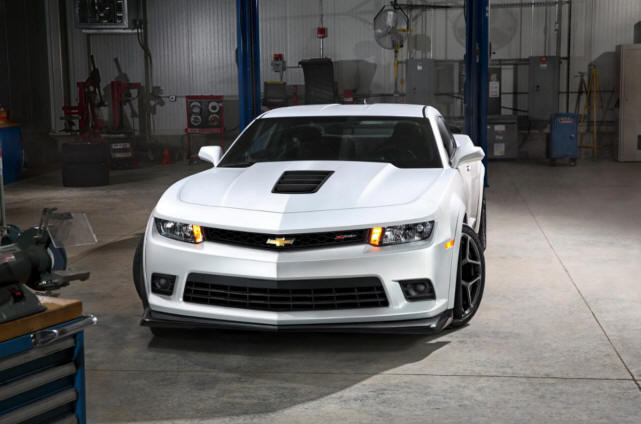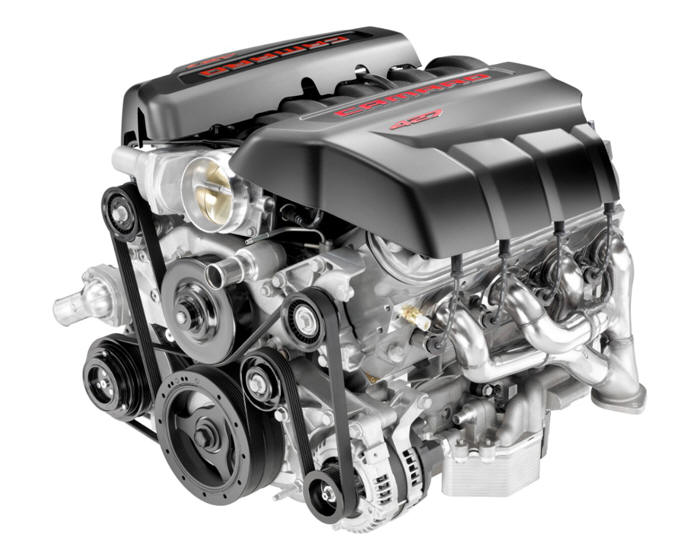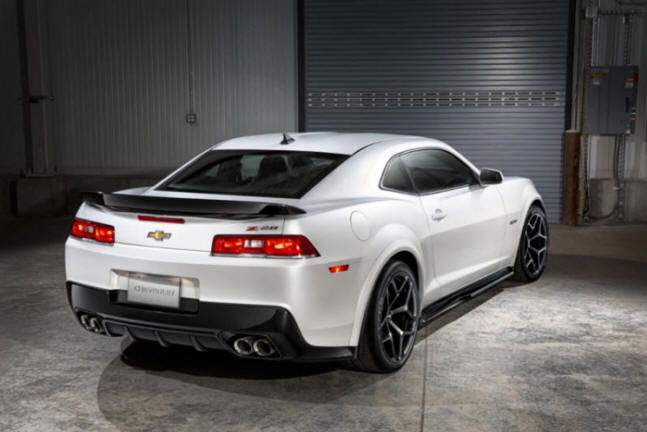 |
|
|
2014 Camaro Z/28 Powered by Racing-Proven LS7 V-8Lightweight, high-flow features contribute to balanced performance, estimated 500 hp2013-03-27
DETROIT – The racing-proven LS7 7.0L V-8 powers the all-new 2014 Camaro Z/28 – the most track-focused production model in the car’s history. It’s matched with a TREMEC TR6060 six-speed manual transmission with unique gearing tailored to the LS7’s performance characteristics for optimal track performance. The Z/28 engine is adapted from the LS7 used in the C6 Corvette Z06, which was developed in conjunction with Corvette Racing. It is rated at an estimated 500 horsepower (373 kW) and 470 lb.-ft. of torque (637 Nm) in the new Camaro Z/28, with a maximum engine speed of 7,100 rpm – a broad rpm range that contributes to higher power and allows the driver to hold gears longer between shifts on the track. That helps keep the engine at peak power for quicker lap times. “The LS7 lives on in the all-new Z/28, extending a performance legacy while delivering great power density in a lightweight package to give this exciting new Camaro a great feeling of control and balance,” said John Rydzewski, assistant chief engineer for small-block engines. “It introduced exotic materials and racing-influenced solutions that keep it at the forefront of high-performance technology.” The LS7 is the most powerful naturally aspirated production engine ever from General Motors and, upon its launch in late 2005, was the first GM engine to receive SAE-certified power ratings. “In the Camaro lineup, it complements a range of great V-8 choices, starting with the 426-horsepower LS3 in the Camaro SS and ending with the supercharged LSA rated at 580 horsepower in the Camaro ZL1,” said Rydzewski. “The LS7’s low mass and high rpm capability make it the perfect choice for the lightweight, track-capable Z/28, exemplifying all the strengths and attributes of the small-block architecture.” Hand-assembled at GM’s Performance Build Center, in Wixom, Mich., the LS7 shares the basic Gen IV V-8 architecture as the Camaro SS’s 6.2L LS3 engine, but it uses a unique cylinder block casting with pressed-in steel cylinder liners to accommodate the engine’s larger diameter, 104.8mm cylinder bores – with deck-plate boring and honing for optimized bore geometry. It also uses a dry-sump oiling system to ensure full lubrication during the 1.05-g cornering loads the Z/28 is capable of producing. Internally, the LS7’s reciprocating components use racing-derived lightweight technology, including titanium connecting rods and intake valves, to boost horsepower and rpm capability – and reduce overall engine mass. The titanium connecting rods provide perhaps the most direct link from the racetrack. They weigh just 464 grams apiece, almost 30 percent less than the rods in the LS3. Besides being lightweight, which enhances high-rpm performance and rpm range, titanium makes the rods extremely durable. Additional engine highlight include:
The LS7 exhaust system for the Z/28 is unique and features a tri-Y header design to take advantage of the V-8’s firing order. Primary pipe pairings join cylinders one and five, then three and seven on the left bank, with cylinders two and four and six and eight paired on the right bank. At each bank, the primary pairings collect into a secondary Y, delivering a combination of pulse separation of adjacent firing cylinders and improved scavenging for the engine’s firing order of 1-8-7-2-6-5-4-3. A dual-mode exhaust system and large, three-inch-diameter pipes complement the manifolds’ tuning and low restriction. The optimized header and exhaust system improves torque and sound quality from the LS7 engine.
High-flow heads The LS7’s CNC-ported aluminum cylinder heads are designed to meet the high airflow demands of the engine’s 7.0-liter displacement, as it ingests more than 100 cubic feet more air per minute than the LS3 V-8 – a nearly 20-percent increase in airflow. To process that airflow capability, a hydraulic roller camshaft with 15mm intake and exhaust valve lift is used to allow plenty of air to circulate in and out of the engine. To ensure optimal, uninterrupted airflow, the LS7’s heads have straight, tunnel-like intake runners. Very large by production-vehicle standards – even racing standards – they are designed to maintain fast airflow velocity, providing excellent torque at low rpm and exhilarating horsepower at high rpm. The heads feature 70cc combustion chambers that are fed by 56mm titanium intake valves, which are larger yet lighter than the valves in the LS3. They are partnered with 41mm sodium-filled exhaust valves, which feature hollow stems partially filled with a special sodium material that melts and liquefies around 205 degrees F (96 C). The inertia from the valves’ opening causes the liquefied sodium to move up inside the stem, dissipating heat better than a conventional exhaust valve. To accommodate the large valve face diameters, the heads’ valve seats are Siamesed; and, taken from experience with the engines of Corvette race cars, the LS7’s valve angles are held at 12 degrees – vs. 15 degrees for the LS3 – to enhance airflow through the ports to get it into the combustions quicker and with less turbulence. Dry-sump oiling system A dry-sump oiling system is used with the LS7 and is designed to keep the engine fully lubricated during the high-cornering loads the Camaro Z/28 is capable of producing. A 10.5-quart reservoir delivers oil at a constant pressure to a conventional-style oil pump pick-up at the bottom of the engine. The pressurized oil feed keeps the oil pick-up continually immersed in oil at cornering loads exceeding 1.05 g. Oil circulates through the engine and down to the oil pan, where it is sent back to the reservoir via a scavenge pump. The large-capacity reservoir, combined with a high efficiency air-to-oil cooler, provides necessary engine oil cooling under the demands of the engine’s power output. With the dry-sump system, oil is added to the engine via the reservoir tank – which includes the oil level dipstick. Then and now The engine in the original 1967 Z/28 was a 302-cubic-inch (4.9L) small-block rated at 290 horsepower and 290 lb-ft of torque. It was created by marrying the iron cylinder block of Chevrolet’s 283 V-8, which had 4.00-inch bores, with the crankshaft of the larger-displacement 327 engine, which delivered a 3.00-inch stroke, creating the 302-cubic-inch displacement that accommodated the engine-size regulation for SCCA’s Trans Am-2 class. With its aluminum cylinder block and heads, as well as a composite intake manifold – and no heavy carburetor – the LS7 engine in the 2014 Camaro Z/28 weighs approximately 20 percent less and produces nearly 73 percent more horsepower than the 1967 302 engine.
2014 CHEVROLET CAMARO Z/28 ENGINE SPECIFICATIONSEngine
|
| C l i c k H e r e to go back a page | |
|
© Official C6
Registry, INC. The Information on the C6 Registry website is
protected by Federal and International © CORVETTE, CORVETTE
LOGOS, and insignia are registered trademarks of the General Motors
Corporation & Chevrolet Motor Division. Chevrolet Motor
Division nor any subsidiaries of GM© shall bear any responsibility
for The Official C6 Registry website content, editorials, or
comments. The Official C6 Registry is independent from General
Motors©, Chevrolet©, or Corvette©, and is not affiliated with,
sponsored or by General Motors©, Chevrolet©, or Corvette©.
|
|


